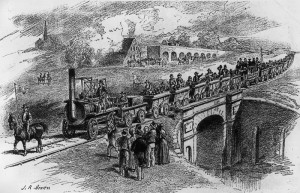HOW THE ANCIENT ROMANS BUILT THE RAILWAYS OF THE WORLD … well strictly speaking they didn’t personally, physically build them but as you will see they did have a direct and material influence on the specification of all modern railways.
Going Back through Time
Now the gauge (ie the width between the two rails) on American Railways is 4 feet 8.5 inches, a pretty odd number ! … Why was that gauge used? Because that’s the way they built them in Britain , and the US railroads were largely built by British engineers.
Why did the British build them like that? Because the first rail lines were built by the same people who built the pre-railroad tramways, and that’s the gauge they used.
Why did “they” use that gauge then? Because the people who built the tramways used the same jigs and tools that they used for building wagons which used that wheel spacing.
Why did the wagons have that particular odd wheel spacing? Well, if they tried to use any other spacing, the wagon wheels would break on some of the old, long distance roads in England, because that’s the spacing of the wheel ruts, some of which were very deep indeed.
So who built those old rutted roads? The first long distance roads in Europe (and Britain) were built by Imperial Rome for their legions. The roads have been used ever since. And the ruts in the roads? Roman war chariots first formed the initial ruts, which everyone else had to match for fear of destroying their wagon wheels. Since the chariots were made for (or by) Imperial Rome, they were all alike in the matter of wheel spacing.
So there you have it. The US and much of the rest of the world, thanks to the British Empire, has a standard railway gauge of 4 feet, 8.5 inches which derives from the original specification for an Imperial Roman war chariot.
BUT … Why did Imperial Roman Build chariots to that width ?
Imperial Roman war chariots were made just wide enough to accommodate the back ends of two war horses. Thus, we have the answer to the original question. [deep breath !]






You must be logged in to post a comment.